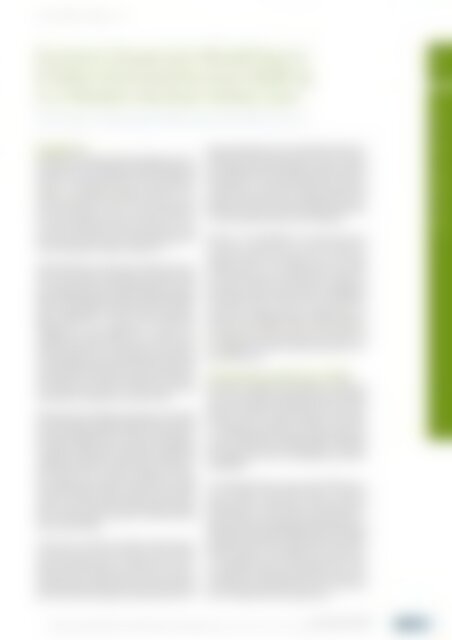atw - International Journal for Nuclear Power | 04.2023
Umwelt, Klima, Energiesysteme Betriebsergebnisse 2022
Umwelt, Klima, Energiesysteme
Betriebsergebnisse 2022
Erfolgreiche ePaper selbst erstellen
Machen Sie aus Ihren PDF Publikationen ein blätterbares Flipbook mit unserer einzigartigen Google optimierten e-Paper Software.
<strong>atw</strong> Vol. 68 (2023) | Ausgabe 4 ı Juni<br />
Dynamic Dispersion Modelling to<br />
Enable In<strong>for</strong>med Decision Making<br />
in a Modern <strong>Nuclear</strong> Safety Case<br />
Howard Chapman, Joseph Hargreaves, Stephen Lawton, Robert Gordon, Tim Culmer<br />
Introduction<br />
Radionuclide material when discharged into the atmosphere<br />
is carried along by the wind and dispersed<br />
into the environment by the action of turbulent diffusion<br />
[1] . As outlined by Hester and Harrison “the<br />
problem of predicting the distribution of airborne material<br />
released from a source is commonly approached<br />
by solving the diffusion-transport equation. There are<br />
a range of models which have been developed to solve<br />
the equation depending upon simplifying assumptions<br />
made and boundary conditions imposed” [2] .<br />
The National <strong>Nuclear</strong> Laboratory (NNL) have historically<br />
used computer modelling techniques which<br />
are based upon the National Radiation Protection<br />
Board (NRPB) Model <strong>for</strong> Short and Medium Range<br />
Dispersion of Radionuclides Released to the Atmosphere,<br />
NRPB-R91 [1] , and Near Wake Modelling,<br />
NRPB-R157 [3] . These approaches are based on a<br />
simplified Gaussian model; but, as with most dispersion<br />
models, there are limitations on the range at<br />
which the model can be appropriately used because<br />
the modelling technique uses weather data from the<br />
release point <strong>for</strong> the whole release path. Other factors<br />
affecting the model can include release height,<br />
topography and deposition, amongst others.<br />
Riskaware have developed an assessment code called<br />
the Urban Dispersion Model (UDM) which estimates<br />
the downwind dispersion of airborne contaminants.<br />
This higher fidelity model can predict atmospheric<br />
transport and dispersion of chemical, biological and<br />
radiological materials within urban and semi-urban<br />
environments, including modelling the effects<br />
of buildings, wake regions, courtyards, and urban<br />
canyons. UDM also models complex material effects<br />
such as wet and dry particulate deposition, primary<br />
and secondary liquid evaporation, and buoyant and<br />
dense gas modelling.<br />
As the need to respond to climate change leads to<br />
renewed interest in the potential <strong>for</strong> new nuclear<br />
energy and deployment as co-generation sites (i.e.<br />
where the heat energy from the reactor is used <strong>for</strong><br />
multiple purposes such as electricity, district heating,<br />
process heat and hydrogen/chemical production) it<br />
becomes important to start considering both the radiological<br />
and chemical hazards in a more rounded<br />
way. Traditionally, nuclear Safety Cases have focused<br />
predominately on the radiological hazards associated<br />
with the site; and where required assessment of<br />
specific chemical hazards are undertaken when the<br />
facilities in question contained significant quantities<br />
of certain hazardous and/or toxic chemicals.<br />
However, as the likelihood of co generation looks<br />
to become a reality there is a need to consider all<br />
hazards related to the activities on a site in a more<br />
complete manner. It is considered that use of UDM<br />
in the nuclear industry could provide a unique opportunity<br />
to improve the assessment of radiological<br />
and chemical aerial release hazards. The approach<br />
would allow safety assessors to compare the consequences<br />
of radiological and chemical hazards in<br />
the same code making it easier and more effective<br />
to balance the risks associated with a facility and<br />
any neighbouring major accident hazard sites in a<br />
more holistic way.<br />
Proposed Future Application of UDM<br />
The aim of this paper is to provide an overview of<br />
the current position regarding dispersion modelling<br />
and how this might be improved by the use of the<br />
Riskaware UDM to support dispersion calculations<br />
in consequence assessment and Safety Case work.<br />
It is also thought that using the enhanced graphical<br />
outputs, provided by the UDM interface, will assist<br />
the engagement process with Regulators and other<br />
stakeholders.<br />
It is anticipated that the output from UDM may be<br />
used to support and provide evidence in decision<br />
making and the overall safety demonstration <strong>for</strong><br />
aerial dispersion in the Safety Case; particularly relating<br />
to the extent of Emergency Planning Zones. An<br />
aspiration <strong>for</strong> the Advance Modular Reactors (AMRs)<br />
programme in the UK is to reduce these zones to be as<br />
small as possible, so that AMRs can be located closer<br />
to industrial clusters and populated areas. This<br />
would allow <strong>for</strong> the heat generated by the reactor to<br />
be utilised more effectively and in new ways beyond<br />
that of traditional electricity generation.<br />
ENVIRONMENT AND SAFETY 63<br />
Environment and Safety<br />
Dynamic Dispersion Modelling to Enable In<strong>for</strong>med Decision Making in a Modern <strong>Nuclear</strong> Safety Case ı Howard Chapman, Stephen Lawton, Joseph Hargreaves, Robert Gordon, Tim Culmer
















